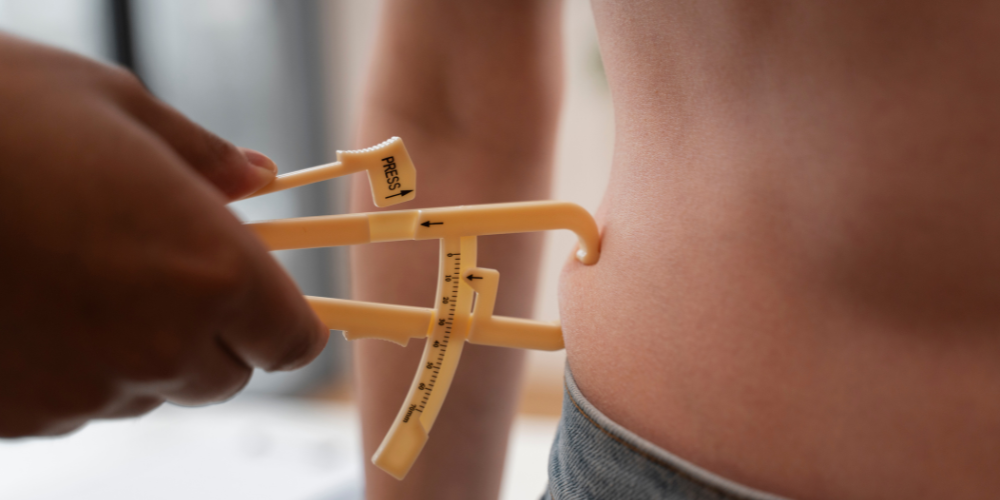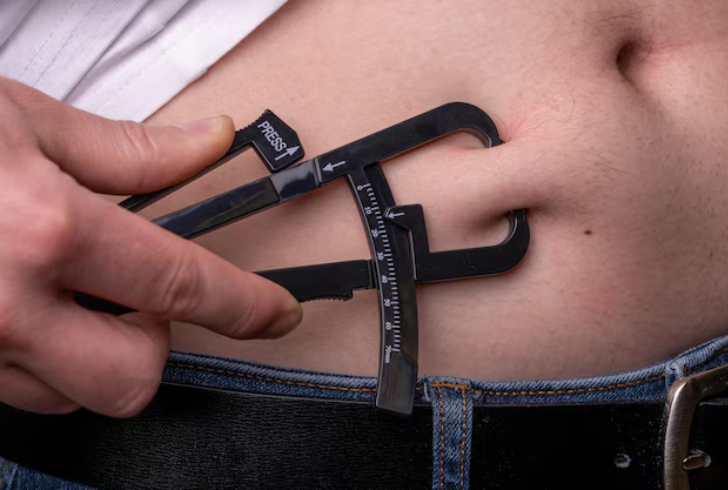
How to Calculate Body Fat Percentage and Maintain a Healthy Range

A healthy body fat percentage doesn’t look the same for everyone. It changes with age, gender, and lifestyle. Understanding where your number falls can help you make informed choices about your overall health.
While some fat is essential for survival, too much can increase the risk of heart disease, diabetes, and other chronic conditions. Knowing how to measure body fat and identify a healthy range offers valuable insight into your physical well-being.
Understanding Body Fat Percentage
Body fat percentage (BFP) shows how much of your body weight is made up of fat tissue. According to Dr. Naomi Parrella from Rush University Hospital, “Body fat percentage offers a more accurate look at someone’s health risks because it changes throughout life, even when weight doesn’t.”
Essential fat protects organs, regulates body temperature, and supports hormonal balance. However, excessive fat can cause serious health concerns, including high blood pressure and cardiovascular disease.
Large studies back this up. A 2019 study on white-British participants linked high body fat to heart valve issues like aortic valve stenosis. Another study from Zhengzhou, China, in 2020 found that waist-to-hip ratio and visceral fat were strong indicators of type 2 diabetes risk in adults.
Healthy Body Fat Percentage Ranges

Freepik | EyeEm | Tracking body fat helps you monitor health and prevent disease.
There’s no single “ideal” number. The healthy range depends on several factors, including gender and age. Still, experts have defined general guidelines that can help people assess their health.
Healthy Body Fat Percentage for Women
Women naturally carry more body fat than men due to hormonal needs and reproductive functions. What’s healthy for one woman might differ for another, so discussing personal health goals with a medical professional is always best.
| Category | Percentage |
| Essential Fat | 10% – 13% |
| Athletes | 14% – 20% |
| Fitness | 21% – 24% |
| Acceptable | 25% – 31% |
| Obesity | Over 32% |
Age also plays a major role. As metabolism slows, maintaining a lower percentage becomes harder. Here’s how healthy ranges change by age group:
| Age | Percentage |
| 20 – 39 | 21% – 32% |
| 40 – 59 | 23% – 33% |
| 60 – 79 | 24% – 35% |
Healthy Body Fat Percentage for Men
Men typically have lower essential fat needs but still benefit from moderate levels for performance and protection. Like women, healthy ranges shift with age.
| Category | Percentage |
| Essential Fat | 2% – 5% |
| Athletes | 6% – 13% |
| Fitness | 14% – 17% |
| Acceptable | 18% – 24% |
| Obesity | Over 25% |
And by age group:
| Age | Percentage |
| 20 – 39 | 8% – 19% |
| 40 – 59 | 11% – 21% |
| 60 – 79 | 13% – 24% |
Methods to Measure Body Fat Percentage
There are multiple ways to calculate body fat, each with its own accuracy and cost. Some can be done at home, while others require professional equipment.
1. Skinfold Calipers
Skinfold calipers estimate fat by gently pinching skin at specific sites, such as the triceps, abdomen, and under the shoulder blade. The measurements are then used in formulas to calculate total body fat.
This method is affordable and widely available, though accuracy can vary between ±3.5% and 5%. Dr. Parrella explains, “Subcutaneous fat under the skin doesn’t always indicate deeper risks. Fat around the organs often causes more serious inflammation.”
2. Bioelectrical Impedance Analysis (BIA)
BIA devices send a low-level electrical current through the body. Muscle, which contains more water, conducts electricity well, while fat slows it down. The device calculates resistance to estimate body fat percentage.
Home-use BIA machines range from $30 to over $1,000. While they can be fairly accurate, hydration, food intake, and recent exercise can affect results. Keeping testing conditions consistent helps improve reliability.
3. Other Advanced Options
For those wanting highly precise results, advanced technologies provide greater accuracy:
1. Hydrodensitometry (underwater weighing): Measures density and is often used in labs or athletic centers.
2. DXA (DEXA) Scan: Uses X-rays to analyze fat, muscle, and bone distribution. It’s considered the most accurate method, typically performed by healthcare professionals.
Body Fat Percentage vs. Body Mass Index (BMI)
BMI is a common tool that categorizes weight based on height. However, it doesn’t distinguish between fat and muscle. For instance, athletes or bodybuilders often fall into overweight or obese BMI ranges despite having low body fat.
Registered dietitian Cassie Vanderwall from the University of Wisconsin-Madison explains, “BMI is a simple ratio that doesn’t consider body composition. Someone with a shorter height or more muscle might show a higher BMI but still be in excellent health.”
BMI also fails to account for factors like age, gender, and ethnicity. Developed nearly 200 years ago by Belgian mathematician Adolphe Quetelet, it was based on white European men, making it less inclusive for diverse populations.
Body fat percentage gives a clearer picture of overall health, but even this doesn’t capture fat distribution. Fat stored around the waist carries higher risks for heart disease compared to fat stored in the thighs or hips.
When to Consult a Doctor

Freepik | ego_tanfreepix | Always consult a doctor about body fat concerns to ensure safe, effective goal-setting.
Checking in with a healthcare professional is essential for anyone concerned about weight, fat percentage, or overall wellness. Doctors can recommend safe, effective strategies for reaching personal goals without compromising health.
Dr. Parrella notes that professional guidance helps tailor approaches to each individual. “Our goal is to help people achieve sustainable changes, not quick fixes that fade in a few weeks,” adds Vanderwall.
Staying Consistent for Lasting Results
Fat is essential for the body, protecting organs, regulating temperature, and supporting hormonal balance. While too little fat can disrupt vital functions, excessive fat increases the risk of chronic illness. Maintaining a healthy balance enhances energy, endurance, and mental clarity.
A proper body fat percentage reflects internal wellness and long-term vitality, not just appearance. Measuring and managing fat levels responsibly allows people to take control of their health safely.
Consistent habits—such as regular exercise, balanced nutrition, and adequate rest—help regulate fat naturally. Tracking changes over time with reliable methods reveals what works best, enabling sustainable progress without extreme measures.
More in Body
-
`
Dwayne Johnson Shocks Fans With Dramatic Weight Loss Transformation
Dwayne “The Rock” Johnson stunned the crowd at the 2025 Venice Film Festival with a slimmer look that set social media...
September 20, 2025 -
`
Dwayne ‘The Rock’ Johnson Stuns Fans With Slimmed-Down MMA Fighter Look
Dwayne ‘The Rock’ Johnson isn’t just flexing muscles anymore. In “The Smashing Machine,” Dwayne Johnson strips down the bulk, sheds his...
September 13, 2025 -
`
Here’s How Fat-Blocking Green Tea Microbeads May Aid Weight Loss
Scientists are exploring an innovative way to reduce fat absorption in the body—tiny edible beads made with green tea, vitamin E,...
September 12, 2025 -
`
Why the Heart Is Slightly to the Left and Not Perfectly Centered
The heart is one of the most vital organs in the body, yet its placement often raises questions. Many assume it...
August 16, 2025 -
`
Ozzy Osbourne’s Most Shocking and Beloved Pop Culture Moments
Few figures in rock history have carved out a legacy as vivid and unpredictable as Ozzy Osbourne. Beyond his groundbreaking work...
August 10, 2025 -
`
Are Mono Diets Worth It – or Just a Dangerous Trend?
As summer brings on the pressure to slim down fast, the internet lights up with diet trends promising instant results. One...
August 3, 2025 -
`
Why Motivation Is Essential for Sustainable Fitness Success
Motivation isn’t something that shows up when it’s convenient—it’s something that needs to be built, shaped, and sustained. Many people struggling...
July 27, 2025 -
`
The Mystery of Human Body Parts That Science Still Can’t Solve
The human body is a patchwork of evolutionary choices, quirks, and mysteries. From skeletal structure to the tiniest gland, everything tells...
July 18, 2025 -
`
Why a Mediterranean Diet and Exercise Slow Bone Loss in Seniors
Bone health isn’t just a concern for the elderly—it’s something that starts to matter the moment the body begins to lose...
July 12, 2025










You must be logged in to post a comment Login